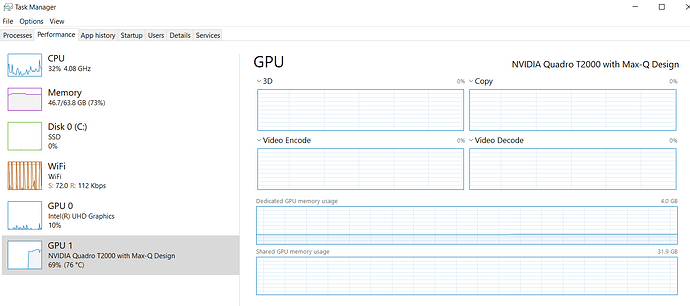Thank you so much again for your advice which was very helpful. IAfter Minst data set, I tried to run a Deep Learning model consist of 70 leyers of LSTM each of with 100 hidden size and the NVIDIA GPU contributed for 70% of computaion in less than a minute!. Here is the plot:
I have a Pyro model in which i use probablistic terms for LSTM blockes, when I do the same process to transfer the model, parameter and data into deveice, the python give bellow error:
RuntimeError: Input and parameter tensors are not at the same device, found input tensor at cuda:0 and parameter tensor at cpu
however I have the same model just transfer to pyro for Bayesian Deep Learning. this my Pyro model:
class Model(PyroModule):
def init(self, input_size=1, num_classes=1, hidden_size=3, num_layers=1, prior_scale=50.0):
super(Model,self).init()
self.num_classes = num_classes
self.num_layers = num_layers
self.input_size = input_size
self.hidden_size = hidden_size
self.activation = nn.ReLU() # or nn.ReLU()
# Correctly initialize the LSTM layer with bidirectional=False
self.lstm = PyroModule[nn.LSTM](input_size, hidden_size, num_layers, batch_first=True, bidirectional=False)
self.linear = PyroModule[nn.Linear](hidden_size, 128) # Adjusted for unidirectional LSTM
self.fc = PyroModule[nn.Linear](128, num_classes)
# Initialize weights and biases for each layer
# Input to hidden layer
self.lstm.weight_ih_l0 = PyroSample(dist.Normal(0., prior_scale).expand([4*hidden_size, input_size]).to_event(2))
self.lstm.bias_ih_l0 = PyroSample(dist.Normal(0., prior_scale).expand([4*hidden_size]).to_event(1))
# Hidden to hidden layer
self.lstm.weight_hh_l0 = PyroSample(dist.Normal(0., prior_scale).expand([4*hidden_size, hidden_size]).to_event(2))
self.lstm.bias_hh_l0= PyroSample(dist.Normal(0., prior_scale).expand([4*hidden_size]).to_event(1))
self.linear.weight = PyroSample(dist.Normal(0., prior_scale).expand([128,hidden_size]).to_event(2))
self.linear.bias = PyroSample(dist.Normal(0., prior_scale).expand([128]).to_event(1))
self.fc.weight = PyroSample(dist.Normal(0., prior_scale).expand([num_classes, 128]).to_event(2))
self.fc.bias = PyroSample(dist.Normal(0., prior_scale).expand([num_classes]).to_event(1))
def forward(self, x, y=None,noise_shape = 0.5):
# Initialize hidden state and cell state
h_0 = torch.zeros(self.num_layers, x.size(0), self.hidden_size).to(device) #hidden state
c_0 = torch.zeros(self.num_layers, x.size(0), self.hidden_size).to(device) #internal state
output, (hn, cn) = self.lstm(x, (h_0, c_0)) #lstm with input, hidden, and internal state
hn = hn.view(-1, self.hidden_size) #reshaping the data for Dense layer next
out = self.activation(hn)
out = self.linear(out)
out = self.activation(out)
mu = self.fc(out)
sigma = pyro.sample("sigma", dist.Gamma(noise_shape, 1)) # infer the response noise
with pyro.plate("data", x.shape[0]):
obs = pyro.sample("obs", dist.Normal(mu, sigma * sigma), obs=y)
return mu
and this my setup for GPU running:
Check for GPU availability
use_cuda = torch.cuda.is_available()
device = torch.device(“cuda” if use_cuda else “cpu”)
Initialize the Bayesian LSTM model
input_size = X_test_tensors_final.shape[2] # Number of features
hidden_size = 2 # Number of features in hidden state
num_layers = 1 # Number of stacked LSTM layers
model = Model(input_size=input_size, num_classes=1, hidden_size=hidden_size,
num_layers=num_layers, prior_scale=50.0).to(device)
Set up the MCMC sampler
nuts_kernel = NUTS(model)
mcmc = MCMC(nuts_kernel, num_samples=50, warmup_steps=50)
Create a combined dataset
dataset = TensorDataset(X_train_tensors_final, y_train_tensors)
Set the batch size
batch_size = 400
Create a DataLoader
data_loader = DataLoader(dataset, batch_size=batch_size, shuffle=False)
Initialize an empty list to store MCMC results
all_mcmc_results =
Iterate over the batches
for batch_idx, (X_batch, y_batch) in enumerate(data_loader):
# Move data to GPU if available
X_batch = X_batch.to(device)
y_batch = y_batch.to(device)
# Run your MCMC simulation
mcmc_result = mcmc.run(X_batch, y_batch)
# Append the result to the list
all_mcmc_results.append(mcmc_result)

